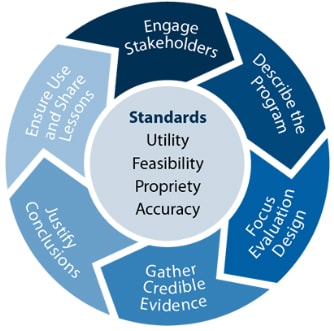Evaluation Resources
Systematic evaluation is a way to improve public health programs and show their results. Evaluations need to be useful, feasible, ethical, accurate, and culturally responsive.
The CDC Framework for Evaluation in Public Health summarizes and organizes essential elements of program evaluation. It can be used with any priority strategy. Using the framework’s steps can improve how program evaluations are conceived and conducted. The six steps are:
- Engage partners.
- Describe the program.
- Focus on evaluation design.
- Gather credible evidence.
- Justify conclusions.
- Ensure use and share lessons.

The framework includes 30 standards. The steps and standards can be integrated into routine program operations. The emphasis on practical, ongoing evaluation involves all program leaders, not just evaluation experts.
Many evaluations use a logic model to depict the relationship between activities and the intended outcomes. A logic model can focus on any level of a program, from the entire organization to a smaller group within the organization, such as one department.
For health equity considerations, identify people most at risk for the health outcome the program is designed to address. Get input from those groups during evaluation design and decision making. Also, develop evaluation instruments, such as information collection tools, that are appropriate for the participants’ culture and the community context.
Addressing Health Equity in Evaluation Efforts [PDF-600KB]
Tips and checklist for integrating health equity considerations in evaluations to understand what works, for whom, and in what conditions. This is part of the Practitioner’s Guide for Advancing Health Equity: Community Strategies for Preventing Chronic Disease.
Baby-Friendly USA Guidelines and Evaluation Criteria
Minimum breastfeeding standards a facility must achieve to become Baby-Friendly designated.
Food Service Guidelines Implementation Toolkit: Monitor and Evaluate
Tools for considering the long-term goals and feasibility of evaluation in terms of cost, time, and availability of personnel to conduct audits.
Planning and Sustaining Your Communication Efforts
On-demand training includes evaluation as part of an eight-step communications planning model.
Tracking Communication Efforts Using the Media Impressions Worksheet
How to measure media impressions and analyze data to inform future communication activities. Also see online training for using the worksheet.
